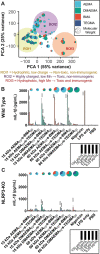Understanding How Cationic Polymers' Properties Inform Toxic or Immunogenic Responses via Parametric Analysis
- PMID: 37781211
- PMCID: PMC10537447
- DOI: 10.1021/acs.macromol.3c01223
Understanding How Cationic Polymers' Properties Inform Toxic or Immunogenic Responses via Parametric Analysis
Abstract
Cationic polymers are widely used materials in diverse biotechnologies. Subtle variations in these polymers' properties can change them from exceptional delivery agents to toxic inflammatory hazards. Conventional screening strategies optimize for function in a specific application rather than observing how underlying polymer-cell interactions emerge from polymers' properties. An alternative approach is to map basic underlying responses, such as immunogenicity or toxicity, as a function of basic physicochemical parameters to inform the design of materials for a breadth of applications. To demonstrate the potential of this approach, we synthesized 107 polymers varied in charge, hydrophobicity, and molecular weight. We then screened this library for cytotoxic behavior and immunogenic responses to map how these physicochemical properties inform polymer-cell interactions. We identify three compositional regions of interest and use confocal microscopy to uncover the mechanisms behind the observed responses. Finally, immunogenic activity is confirmed in vivo. Highly cationic polymers disrupted the cellular plasma membrane to induce a toxic phenotype, while high molecular weight, hydrophobic polymers were uptaken by active transport to induce NLRP3 inflammasome activation, an immunogenic phenotype. Tertiary amine- and triethylene glycol-containing polymers did not invoke immunogenic or toxic responses. The framework described herein allows for the systematic characterization of new cationic materials with different physicochemical properties for applications ranging from drug and gene delivery to antimicrobial coatings and tissue scaffolds.
© 2023 The Authors. Published by American Chemical Society.
Conflict of interest statement
The authors declare no competing financial interest.
Figures







References
-
- Lostalé-Seijo I.; Montenegro J. Synthetic materials at the forefront of gene delivery. Nat. Rev. Chem. 2018, 2 (10), 258–277. 10.1038/s41570-018-0039-1. - DOI
Grants and funding
LinkOut - more resources
Full Text Sources
